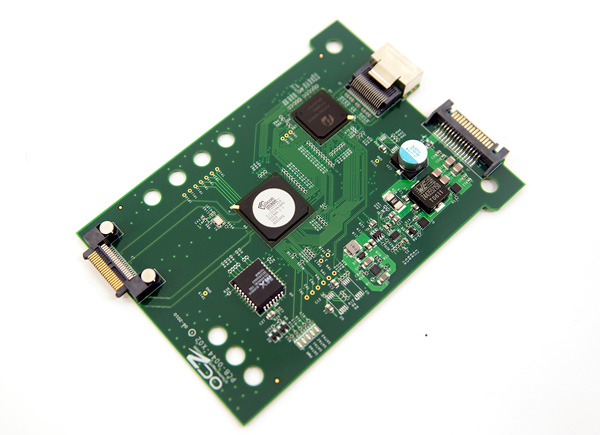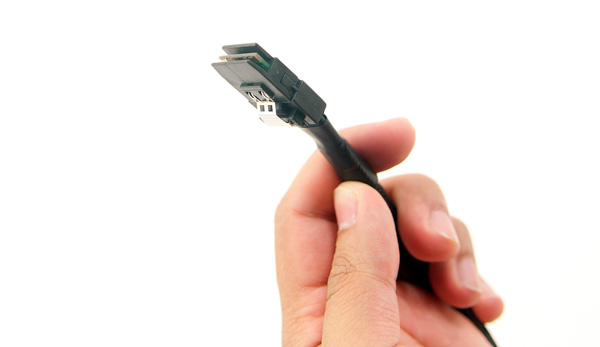OCZ's Fastest SSD, The IBIS and HSDL Interface Reviewed
by Anand Lal Shimpi on September 29, 2010 12:01 AM ESTFinal Words
The OCZ IBIS is very fast as you’d expect. Technically it’s the fastest SSD we’ve ever tested, but that’s because it’s actually four SF-1200 SSDs in a single 3.5” chassis. From a cost standpoint you’re better off grabbing four SandForce drives and rolling your own RAID, but if for whatever reason you don’t want to do that then a single IBIS will get the job done. It's faster than a Colossus by a huge margin and even faster than OCZ's recently introduced RevoDrive, you just need the workload to stress it.
I’m very comfortable with SandForce as a controller when it comes to not having TRIM. The IBIS’ garbage collection is aggressive enough to fix any significant fragmentation with a bit of idle time.
As I mentioned earlier however, the real goal here is to RAID multiple IBIS drives together with the 4-port card. We measured maximum sequential throughput of 675MB/s for a single IBIS drive, assuming somewhat linear scaling you can expect over 2.5GB/s out of a 4-drive IBIS array. This would be all off of a single PCIe x16 card. At this point the 4-port cards aren’t bootable, OCZ believes it is still several weeks away from having that support enabled.
Introducing a new interface is a very bold move for a company whose start was as just another memory vendor. I asked Ryan if motherboard manufacturers were signed up to deliver boards with HSDL connectors, he said they were. Although motherboard manufacturers often agree to do a lot that doesn’t end up being a launched, retail product. Motherboard makers aren’t the only ones who have taken notice as apparently RAID card manufacturers also want a piece of the HSDL pie. All of this is completely up in the air at this point. It’s one thing to mention you have lots of interest, it’s another to point at a mature market with products actually launching. Getting any company, much less a motherboard or RAID card manufacturer to commit resources to delivering features that support a market of zero is a tall order. I’m not saying it can’t be done, I’m saying that if Ryan Petersen can achieve it, he will have been the first to do it among a long list of memory companies who tried to be something more.
Ryan and OCZ are doing what they’re good at: finding a niche and trying their best to get there quicker than the big guys. There’s simply no PCIe SSD standard for the high end. For a single PCIe SSD there’s not much need, but if you want to RAID together multiple PCIe SSDs you’ll either run out of PCIe slots or have a very fast, very unbootable RAID.
The HSDL standard is completely open. OCZ tells me that there’s no licensing fees and all companies are completely free to implement it. In fact, that’s what OCZ would like to see happen. Currently the only way to get the HSDL spec is to contact OCZ and request it but the company is apparently working on setting something up a little more open. At the end of the day OCZ still wants to make money selling SSDs. HSDL’s success would simply let the company sell more expensive SSDs.
Drives will be available in two weeks but let's hope some of these integrated motherboard designs pan out.
HSDL sounds like a simple solution to the problem of delivering more interface bandwidth to SSDs. The interface should scale well since it’s built on PCIe, it’s just a matter of whether or not companies will support it. I believe it’s at least worth a try.












74 Comments
View All Comments
punjabiplaya - Wednesday, September 29, 2010 - link
If I understood this correctly, OCZ is just using PCIe signaling over a SAS cable (with accompanying card to demux and pass on to the PCIe lanes)? That's ingenious.davecason - Wednesday, September 29, 2010 - link
This method also makes it easy to port it to a laptop interface through an express card socket.vol7ron - Wednesday, September 29, 2010 - link
Isn't that what PCIe RAID controllers do (minus the SAS cable)?TinyTeeth - Saturday, October 2, 2010 - link
I'm pretty sure they communicate with regular SATA SSD drives through the SATA interface, whereas HSDL brings PCIe all the way to the SSD drive. This would be why IBIS supports much higher IOPS than previous PCIe SSD solutions like the Z-Drive (which were limited by SATA RAID). Someone please correct me if I'm wrong about this.Ethaniel - Wednesday, September 29, 2010 - link
675 MB/s in sequential write? I just feel sad all of a sudden. SSDs are so forbidden for me right now, but this is a true monster. Maybe they'll make a more "down-to-Earth" version next time. Good stuff, anyway.vol7ron - Wednesday, September 29, 2010 - link
If only I could burn DVDs that fast.Lerianis - Saturday, October 2, 2010 - link
You still burn DVD's? Hell, I stopped doing that a few months ago when I realized that 99% of the stuff I burned was really a 'watch-once and never again' thing and went out to get one of those 2.5" 1TB external hard drives.Haven't burned another DVD since.
rqle - Wednesday, September 29, 2010 - link
too much proprietary peripherals, if i am going to use a PCIe card, I might as well just stick with a revodrive. pcie slots, proprietary slots connectors, proprietary cable, proprietary disk drive interface, blah. ill just stick with their own revodrive for now and wait for sata or sas controllers to pick up speed.jo-82 - Wednesday, September 29, 2010 - link
SAS cabels aren't that expensive these days, and the most companies who would by one of these use them today anyway.And good luck waiting the next 3-5 years or so for SATA 12GB ;)
vol7ron - Wednesday, September 29, 2010 - link
Gb, not GB